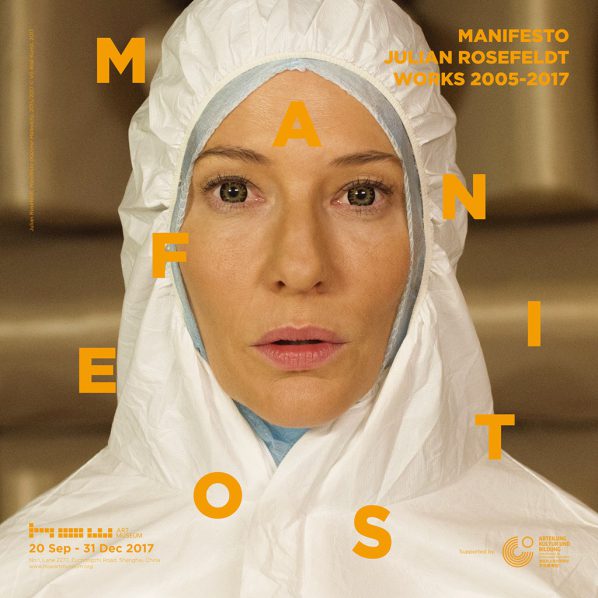
HOW Art Museum (Shanghai) is pleased to announce its inaugural exhibition MANIFESTO: Julian Rosefeldt. Works 2005-2017, on view from September 20, 2017 to December 31, 2017. It is the first comprehensive institutional solo show of Julian Rosefeldt in China since 2012 and presents important aspects of Rosefeldt’s production over the past 12 years. Comprising five film installations and 21 photo works, the recent and widely known work Manifesto marks the heart of the exhibition. It is great honor of How Art Museum to present the film installation for the very first time in Asia on occasion of the museum’s opening.
Manifesto (2015) is a 13-channel film installation that pays homage to the moving tradition and literary beauty of artist manifestos. Manifesto draws on the writings of Futurists, Dadaists, and other artist groups, as well as the musings of individual artists, architects, dancers and filmmakers. Passing the ideas of Kazimir Malevich, André Breton, Jim Jarmusch and other influencers through his lens, Rosefeldt has edited and reassembled thirteen collages of artists’ manifestos.Performing this ‘manifesto of manifestos’ as a contemporary call to action, while inhabiting thirteen different personas – among them a school teacher, a newsreader and a homeless man – Australian actress Cate Blanchett imbues new, dramatic life into both famous and lesser known words within unexpected contexts. Often written in youthful rage, they not only express the wish to change the world through art but also reflect the voice of a generation. Manifesto questions whether the words have withstood the passage of time and how the dynamics between politics, art and life have shifted. What is the role of the artist in society today?
Next to this central piece, Rosefeldt’s two most recent film works are presented. Recalling his typical style by forgoing language and praising distance shots, the works comment upon recent discourses debating the future of our planet and society, while referring to different film genres. The Swap (2015) plays on the covert dodgy dealings in classic gangster films. Set at a deserted container terminal, two rival mobs pull up in cars – clad inleather, guns poised; the gestures are exaggerated and the exchange plays out into a dance with the briefcases forever changing hands. The absurdity of the endless swap can be read as a comment on the increasingly uncontrollable monetary transactions which have become almost ritualistic yet elusive to those who live in today’s globalised world.
In the Land of Drought (2015 / 2017) confronts man’s impact on the world. In the tradition of sci-fi movies, the piece looks back from an imagined future upon the post-Anthropocene: the aftermath of significant human influence on Earth. An army of scientists appear to investigate archeologically at the remnants of civilisation after humanity has made itself extinct. Shot entirely using a drone, Rosefeldt's images hover meditatively over the desolate landscape and ruins.
Rosefeldt previously addressed modern man’s alienation from nature in works such as the 3-channel installation Clown (2005). An absurd scene unfolds when the slightly uncanny figure of a clown emerges from the impenetrable lushness of the jungle. Starting from the right-hand side, he passes through all three screens, stumbling towards the viewer, before finally disappearing back into the jungle. As often in Rosefeldt’s work, this film’s protagonist is an uncommunicative, self-absorbed monad: a wanderer in a world he either does not understand or – caught up in activities required by the closed circuit of his solecistic, madcap logic – wishes to ignore.
On the second floor Rosefeldt’s exploration of the relationship between man and nature is brought to another level. The installation The Ship of Fools (2007), and photo works from different series, demonstrate the strong boundaries between the notions of nature, arts and politics as they once appeared during the period of German Romanticism. The work is a sceptical epitaph on German sensitivities and on the still problematic dealing with German identity.
The exhibition receives special support from the Department for Culture and Education of the German Consulate General in Shanghai (AKuB).
About Julian Rosefeldt
Julian Rosefeldt, born in Munich, Germany in 1965, is a Berlin-based artist and filmmaker. He is internationally renowned for his visually opulent and meticulously choreographed moving image artworks, mostly presented as complex multi-screen installations. Inspired equally by the histories of film, art and popular culture, Rosefeldt uses familiar cinematic tropes to carry viewers into surreal, theatrical realms, where the inhabitants are absorbed by the rituals of everyday life, employing humour and satire to seduce audiences into familiar worlds made strange. Rosefeldt currently holds a professorship of Digital and Time-based Media at the Academy of Fine Arts in Munich since 2011.
Rosefeldt has had numerous international, solo exhibitions at museums such as the Park Avenue Armory Hall, New York (2016 / 2017), the Hamburger Bahnhof – Museum für Gegenwart in Berlin (2016), the ACMI – Australian Centre for the Moving Image (2015) and many more. Past group shows include Moving Time: Video Art at 50: 1965 - 2015 at CAFA Art Museum, Beijing (2016), Wolfsburg Unlimited at the Kunstmuseum in Wolfsburg (2016), Zeitgeist: The Art of New Berlin at the CCBB in Rio de Janeiro (2016) and Conflict, Time, Photography at the Tate Modern in London (2014). His work is held in collections including the Neue Nationalgalerie, Berlin, Saatchi Collection, London and the Museum of Modern Art, New York, amongst others.
About the exhibition
Dates: 2017.09.20 – 2017.12.31
Venue: How Art Museum
Courtesy of the artist and HOW Art Museum, for further information please visit www.howartmuseum.org.




























